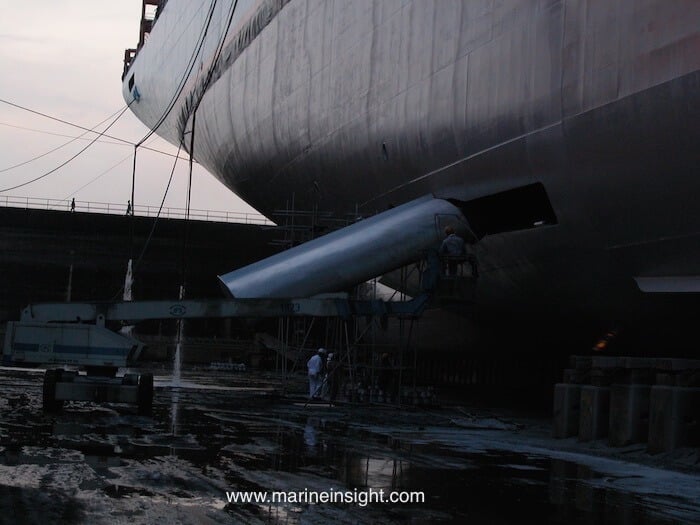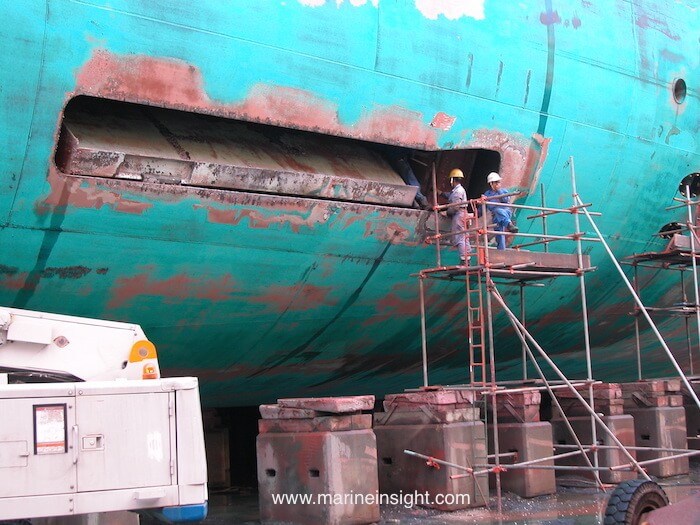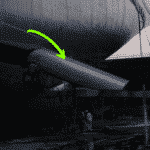Understanding Ship Fin Stabilizer and Its Operation
The function of a fin stabilizer, found at the bottom part of the ship’s hull, is to provide resistance to the excess rolling of ship in either direction. Many seafarers have not seen a real fin stabilizer until the ship goes to dry dock for hull inspection and surveys. This does not rule out the knowledge that every onboard engineer and officer must posses regarding the components and functioning of fin stabilizer system.
Let’s take a look at the main components of fin stabilizer of ship.

Components
1. Two fins forming part of the hull structure of the ship, one port and one starboard.
These fins are connected to fin stabilizer room on port and starboard sides of the ship from where they are operated/ controlled
Each stabilizer consists of a fin box, which houses a fin and supports the fin actuating machinery. Each stabilizer machinery unit provides the support and the means by which the fin may be rigged in or out, locked and tilted up to +/-25 degrees.
2. Two hydraulic power units located in the stabilizer room PS and SB, power the fin tilting and rigging motions
3. Bridge Control Panel (BCP) provides control and indicators for remote operation from bridge. The panel is installed in the BMCC.
4.Two local control units (LCU) are located in each stabilizers room. These panels are providing local indication and control of the fin.
5. Main Control Unit (MCU) – This panel can control fins from ECR with the same features as bridge control unit. LCU display for starboard and port is present in MCU.
6. Roll Motion Sensor Unit (RMSU) measures ship’s roll acceleration and provides the control signal for the roll control algorithm and interfaces to the Main Control Unit (MCU).
The RMSU comprises of a solid state sensor and signal conditioning electronics. Sensor is located in MCU.
7. Fin Angle Feedback Transmitter provides the fin angle position signal for the servo controller. A fin angle indicator mechanically coupled to the tilt cylinder piston rod and the fin angle transmitter shows the fin tilt angle.
8. The Stroke Control Unit (SCU) is mounted on the variable delivery pump. It provides drive and feedback of the position of the pump’s control spindle.

Operation
• A Hydraulic Power Unit (HPU) powers the fin tilting and rigging motions. Built into the HPU is a high power electric motor driving a variable delivery piston pump with a tandem vane pump for control pressure. A second vane pump for fin rigging and pump replenishment is driven from the other end of the main motor
• A variable delivery piston pump controls fin tilting. The flow rate of this pump is controlled by a rotary valve that is positioned by the Stroke Control Unit
• The SCU consists of a servo motor and gears with an integral resolver, mounted within rectangular cast box. The LCU contains circuitry to provide microprocessor based control of the SCU, and hence the direction and rate of flow from the pump. The fin’s rotational velocity is proportional to the pump flow rate
• Fin rigging is controlled by solenoid actuated valves. The HPU also provides the means for stowage of the fin under emergency power. A second electric motor (of lower power) is connected to a constant delivery gear pump. This pump is connected to an auxiliary set of solenoid controlled valves that can be used to tilt the fin to zero angles and rig it in.
• The operation can be controlled from bridge or ECR. A selector switch located on the MCU control panel allows the MCU to become the active control station if the BCP or communication to the BCP becomes defective
Following preparation must be done before operating the fin stabilizer:
Before starting the Gyro fin Stabilizer System, the Engine Room should confirm:
1. There are no obstructions to the moving parts of the Stabilizer Machinery.
2. Cooling water is flowing through the Hydraulic Power Unit heat exchanger.
3. All local power isolation switches to controls and pumps are turned ON.
Over to you..
What according to you are important points to consider while operating fin stabilizers?
Let’s know in the comments below.
Disclaimer :
The information contained in this website is for general information purposes only. While we endeavour to keep the information up to date and correct, we make no representations or warranties of any kind, express or implied, about the completeness, accuracy, reliability, suitability or availability with respect to the website or the information, products, services, or related graphics contained on the website for any purpose. Any reliance you place on such information is therefore strictly at your own risk.
In no event will we be liable for any loss or damage including without limitation, indirect or consequential loss or damage, or any loss or damage whatsoever arising from loss of data or profits arising out of, or in connection with, the use of this website.
Do you have info to share with us ? Suggest a correction
Disclaimer :
The information contained in this website is for general information purposes only. While we endeavour to keep the information up to date and correct, we make no representations or warranties of any kind, express or implied, about the completeness, accuracy, reliability, suitability or availability with respect to the website or the information, products, services, or related graphics contained on the website for any purpose. Any reliance you place on such information is therefore strictly at your own risk.
In no event will we be liable for any loss or damage including without limitation, indirect or consequential loss or damage, or any loss or damage whatsoever arising from loss of data or profits arising out of, or in connection with, the use of this website.

About Author
An ardent sailor and a techie, Anish Wankhede has voyaged on a number of ships as a marine engineer officer. He loves multitasking, networking, and troubleshooting. He is the one behind the unique creativity and aesthetics at Marine Insight.
Latest Marine Technology Articles You Would Like:
Subscribe To Our Newsletters
By subscribing, you agree to our Privacy Policy and may receive occasional deal communications; you can unsubscribe anytime.











On the issue of ship fin stabilizer i find it very detailed and educative for seafares.
Thats an excellent piece of an article to read and get the necessary knowledge.
What a masterpiece info!
4 points:
1. Deploy the fins in time.
2. Before berthing, make sure the fins are housed.
3. In icy waters, deactivate the fins before entering any icefields
4. Do not use the fins if not necesery. House the fins as soon as the sea state alowes.
One particular thing to remember regarding fin-stabilizers is to retract them prior berthing. When the PAX-ship of Hurtigruten that was burning, experienced heavy listing when assisted to berth – and it turned out that the fins was still out and was pushed in creating heavy leaking.
How much is the maximum amount of power absorbed by the bigest pair of these de ices ? Thanks.
More years ago that I would want to remember I was assigned to a section of the QE1’s maiden voyage around the Cape of Good Hope.
I was thrilled but also scared stiff due to the possibility of sea sickness.
Our shipping correspondent assured me however that with the ship’s fins (modern at the time) there was no chance that I would get sick.
However. I got sick as a dog when we neared the Cape of Storms.
It turned out that the role of ship utilizing the fins was not the cause of the problem but the ship battling the storm and waves in front of the ship.
I thought that was not a good answer due to the size of the ship.
Could someone please help?
Is this stabilizer use the same principles as the aileron on airplane?
@Moh: No. The airplane fin designs are based on aerodynamics
stabilizers are dependent on ships designed speed on my opinion